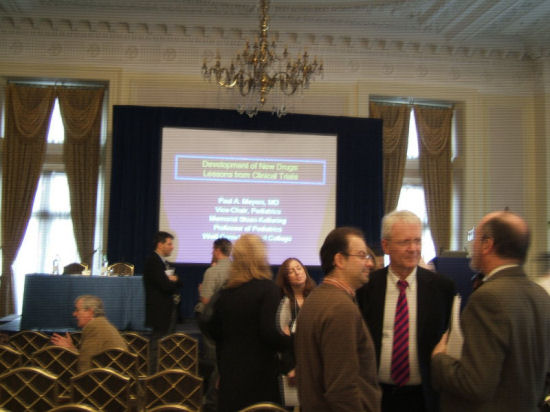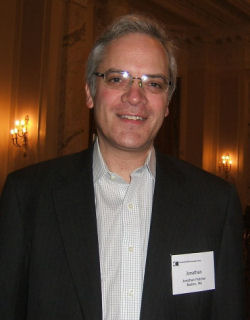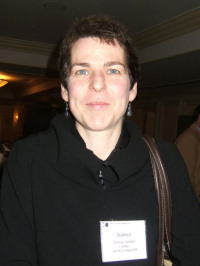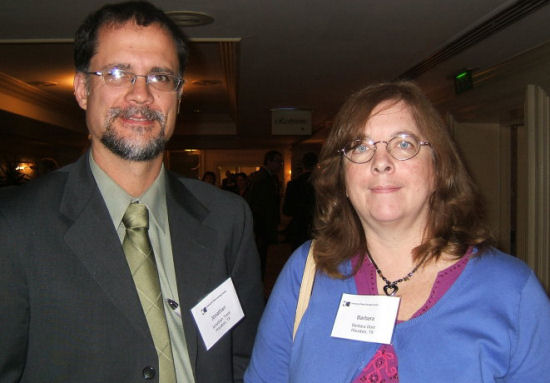Attending CTOS conference: a whirlwind experience!
by Barbara Dore
I had the chance to represent GSI at CTOS (Connective Tissue Oncology Society), which was held in London November 13 -15th in the Landmark Hotel. The Landmark Hotel is rather a grand red-brick Victorian Railway hotel, built at the terminus of the Grand Central Railway line in the days when steam trains ran and horses and carriages filled the streets.
I mention this as the whole conference took place in these opulent settings — the scientific papers were delivered in the Ballroom, rows and rows of chairs arrayed under an elaborately corniced ceiling, enormous chandeliers dripping with crystal glass, and a minstrels gallery discretely tucked away at one end. For modern use a platform was set up at one end of the room for the speakers — the session Conveners up on the left side of the platform, with the Speaker’s lectern on the right, and a very big screen centrally behind. There were repeater screens throughout the room so that everyone could see the slides accompanying the talks.

People ambled in and out between talks, into the foyer, breaking into small groups to meet up with colleagues from distant places, make new friends and discuss the proceedings of the meetings. Beyond the foyer is a grand hallway and a roaring log fire, where huddles of scientists could be seen talking away on the clustered sofas. At the end of the foyer was another room similar to the Ballroom, referred to as the music room, which was filled with posters surrounding a central table laden with coffee and tea.
 The first day started at the crack of dawn — Registration commenced at 7 am with the opening talk by Jonathan Fletcher due at 8. I collected my badge and conference book and wandered over to the other music room to investigate the promised ‘Continental Breakfast’. Although it was also the poster room, few of the day’s posters were actually arrayed yet. There were none there at that point on GIST, so I returned to the Ballroom to attend the initial SARC meeting (a biennial event) and spotted Dr. Fletcher setting up for his inaugural talk — so I thought this was an ideal opportunity to get his photo! He kindly agreed, and I was on the way to completing my collection! His talk was a review of the current knowledge of GIST, which is reported upon elsewhere. Several other talks ensued, and after a couple of hours I thought I had better attend the final hour of the advocate groups meeting. I had missed most of it — as the SARC meeting had many GIST talks I thought I had better attend.
The first day started at the crack of dawn — Registration commenced at 7 am with the opening talk by Jonathan Fletcher due at 8. I collected my badge and conference book and wandered over to the other music room to investigate the promised ‘Continental Breakfast’. Although it was also the poster room, few of the day’s posters were actually arrayed yet. There were none there at that point on GIST, so I returned to the Ballroom to attend the initial SARC meeting (a biennial event) and spotted Dr. Fletcher setting up for his inaugural talk — so I thought this was an ideal opportunity to get his photo! He kindly agreed, and I was on the way to completing my collection! His talk was a review of the current knowledge of GIST, which is reported upon elsewhere. Several other talks ensued, and after a couple of hours I thought I had better attend the final hour of the advocate groups meeting. I had missed most of it — as the SARC meeting had many GIST talks I thought I had better attend.
The advocate groups meeting was attended by Bruce and Beverly Shriver, The UK Sarcoma Group, the Sarcoma Alliance, The GISTsupportUK group and Estelle Lacointe from France. I arrived in time to hear Estelle tell her story of how, when she found there was little support in France for patients with rare cancers she got involved with an advertising campaign to educate the public. The campaign has escalated until Estelle has met the President of France, there is to be a network of specialist centers which all patients with rare cancers will be referred to, and Estelle was to attend the first French national gathering for rare cancers the following week. They have come a long way!
 On my return to the Ballroom to see I spotted Dr. Beatrice Seddon, pictured at the right, whom I had met in London before I departed for Houston earlier this year. Dr. Seddon gave a poster about the worldwide treatment-use trial for Sutent.
On my return to the Ballroom to see I spotted Dr. Beatrice Seddon, pictured at the right, whom I had met in London before I departed for Houston earlier this year. Dr. Seddon gave a poster about the worldwide treatment-use trial for Sutent.
People were milling about and enroute to lunch. After lunch I went to view the posters now fully arrayed.
I had just spotted the NIH clinic poster when I was lucky enough to spot Dr. Su Young Kim himself, just collecting a cup of coffee. Dr. Kim had recently very kindly written an article for the Fall Newsletter, so I managed to get of photo of us together, next to the NIH poster, holding the Newsletter! He confided in me that he had liked the presentation of his article in the Fall Newsletter, so was going to emulate it in some later articles for patients.
Back in the lobby I came across Dr. Trent from MD Anderson, who also agreed to have his photo taken with me (see below).

Returning to the Ballroom I found that all the seats in the entire room were taken up, so returned to the lobby to talk to Beverly and Bruce Shriver, experienced Conference visitors that they are.
Later in the afternoon I took advantage of a tea break to return to the Ballroom and managed to hear a few more talks before I retired home — at 6 pm I was too tired to attend the evening reception — I had been at the conference for 11 hours!
On Friday 14th November I returned at midday just after everyone had another excellent three course lunch and attended Meg von Mehren’s talk in the Ballroom among others. She also graciously agreed to allow me to take her photo, and then I was introduced to Anette Duensing, whose talk I had attended earlier. Naturally I gained her photo, too. Wandering back into the Ballroom during the afternoon break I came across Jonathon Weber talking informally with colleagues — when I asked for a photo they very kindly all started to spring out of their chairs to pose — but I thought their informal grouping was charming and so asked them to stay put.
The final day dawned, and the final posters were my first object, as there were several on GIST that day. I introduced myself to the Novartis representatives, firstly Jenna Fan — who has an impressive array of degrees — MD, PhD, MBA degrees, who has been in New Jersey for years and works for Novartis Global Product Strategy and Scientific development. She is following the Gleevec adjuvant therapy trials in Scandinavia and Europe with great interest, and I am sure we will stay in contact.
I did speak to Karen McDougall from Novartis briefly, too, after she had been speaking to Dr. Jon Trent and others in the lobby of the hotel sitting around the big log fire. She told me Novartis and Dr. Trent were working on several projects – some ongoing and some in the pipeline.
Every day of the conference the posters were changed to a new set, and GIST related posters were in the minority. However, looking at posters of other sarcomas did show me that there are commonalities between GISTs and other sarcomas — certainly the treatments and the challenges are similar. Some sarcomas such as desmoids even have known mutation patterns, many seem to respond poorly to conventional chemotherapy, with some success with various biological targeted therapies, and for all I think the primary treatment is either wait-and-see or surgical excision. All sarcomas seem to be rare cancers; many seem to be very hard to treat.
But the atmosphere in the room was invigorating — with a buzz of excitement; of being at the frontier of science, on the verge of a wonderful breakthrough. The science is fascinating, the goal achievable, the comradeship palpable.
I looked around, and many of the familiar names one sees again and again on scientific papers were there in the room — from Italy, France, the UK, USA, Canada, Belgium, Japan, Spain, Germany, the Netherlands, Denmark. With all these great minds teasing apart the intricate three dimensional spider’s web of dynamic chemical relationships that makes up the molecular machinery of our cells, it looks as though in the future we may be able to target cancers from different angles thro
ugh various pathways simultaneously — and tame them, once and for all. Bye, bye GIST!
For a summary of the scientific findings presented, see this separate story.

